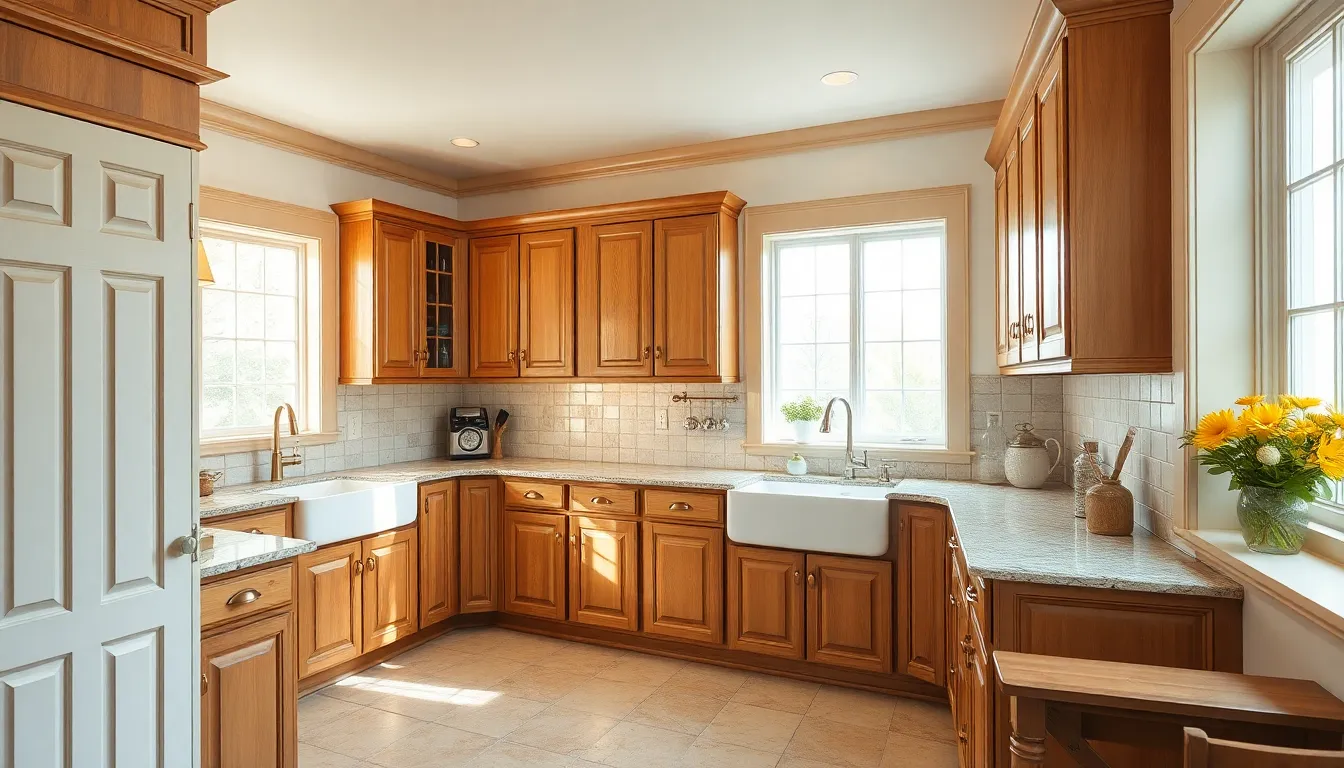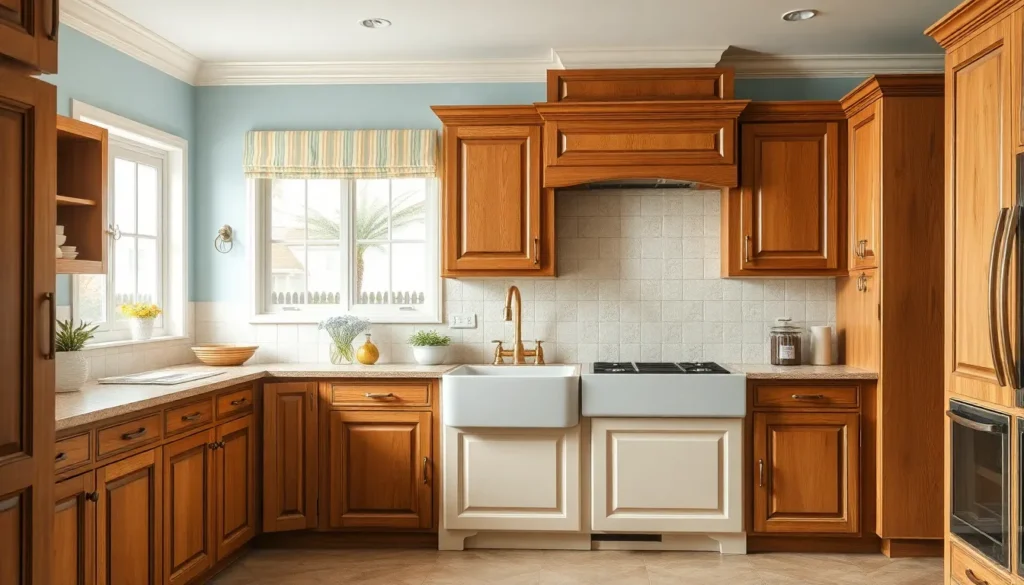Table of Contents
ToggleTraditional kitchens evoke a sense of warmth and nostalgia, blending timeless design with modern functionality. These spaces often feature classic elements like wooden cabinetry, intricate moldings, and inviting color palettes that create a cozy atmosphere. The charm of a traditional kitchen lies in its ability to foster connection, making it the heart of the home where families gather to share meals and stories.
In a world that increasingly embraces minimalism and contemporary styles, traditional kitchens stand out for their rich history and enduring appeal. They celebrate craftsmanship and attention to detail, showcasing materials that have stood the test of time. Whether it’s a farmhouse-inspired layout or a classic colonial design, these kitchens offer a unique blend of comfort and elegance, inviting anyone who enters to experience the joy of cooking and togetherness.
Overview of Traditional Kitchens
Traditional kitchens embody warmth and nostalgia, characterized by classic design elements like wooden cabinetry and intricate moldings. Common materials include oak, cherry, and maple, which enhance the kitchen’s inviting atmosphere. The use of muted colors, such as cream, soft blues, and earthy tones, creates a cozy environment conducive to family gatherings.
Key features often found in traditional kitchens include:
- Custom Cabinetry: Tailored designs maximize storage while showcasing craftsmanship.
- Detailed Moldings: Crown moldings and wainscoting add elegance and depth.
- Farmhouse Sinks: Deep sinks provide functionality and a rustic appeal.
- Timeless Hardware: Knobs and pulls in brass or oil-rubbed bronze enhance authenticity.
Despite the popularity of minimalism, traditional kitchens retain their charm and appeal. Their craftsmanship and design create a unique blend of comfort and elegance, inviting individuals to engage in cooking and sharing meals. Families often find these kitchens serve as the heart of the home, fostering connection through the preparation and enjoyment of food.
Key Features of Traditional Kitchens

Traditional kitchens incorporate elements that evoke warmth and nostalgia, making them functional and inviting spaces. Key features include specific materials and design elements that define their classic charm.
Materials Used
- Wood: Oak, cherry, and maple are popular choices for cabinetry and countertops, providing durability along with an aesthetic appeal.
- Natural Stone: Granite and marble enhance elegance, making them preferred materials for backsplashes and countertops.
- Ceramic Tiles: Often used for flooring, ceramic tiles offer a timeless look and withstand heavy foot traffic well.
- Brass and Oil-Rubbed Bronze: These materials adorn hardware and fixtures, adding authenticity and a vintage touch to the kitchen.
Design Elements
- Custom Cabinetry: Tailored cabinetry maximizes storage while showcasing craftsmanship through dovetail joints and detailed finishes.
- Detailed Moldings: Crown moldings, chair rails, and decorative trims add dimensionality and visual interest to the kitchen’s architecture.
- Farmhouse Sinks: Apron-front sinks combine functionality with rustic charm, serving as statement pieces within the space.
- Timeless Hardware: Pulls and knobs in classic finishes like brass or oil-rubbed bronze enhance the traditional aesthetic.
- Color Palette: Muted shades such as cream, soft blue, and earthy tones create a soothing environment, promoting a sense of comfort.
Popular Styles of Traditional Kitchens
Traditional kitchens encompass various styles, each reflecting unique historical influences and aesthetic preferences. Key styles include Country, Colonial, and Victorian, each offering distinct characteristics and charm.
Country Style
Country-style kitchens emphasize simplicity and warmth, often featuring rustic elements. Decor incorporates open shelving, farmhouse sinks, and distressed cabinetry in shades such as soft whites and pastel hues. Materials like reclaimed wood add authenticity, while accessories like vintage tableware and woven baskets enhance the inviting atmosphere. Blending practicality with charm, these kitchens instill a sense of tranquility reminiscent of countryside living.
Colonial Style
Colonial-style kitchens showcase symmetry and classic design, drawing inspiration from America’s early settlers. These kitchens feature elegant wooden cabinetry with raised panel doors in deep hues like navy, green, or burgundy. The use of natural stone for countertops, paired with detailed crown moldings, adds sophistication. Iconic elements include central islands for food preparation and classic chandeliers that illuminate the space, reflecting historical influences while maintaining functionality.
Victorian Style
Victorian-style kitchens highlight ornate details and elaborate finishes, reflecting the opulence of the era. Rich woods such as mahogany create a luxurious feel, often complemented by intricate moldings and decorative tile backsplashes. Color palettes range from deep jewel tones to soft pastels, creating depth and interest. Features like tin ceilings, ornate hardware, and plush seating areas foster both elegance and comfort, making them ideal for entertaining and family gatherings.
The Role of Color in Traditional Kitchens
Color plays a crucial role in defining the ambiance of traditional kitchens. Soft hues in muted shades create a warm and inviting space. Cream, soft blues, and earthy tones complement wooden cabinetry, enhancing natural beauty. These colors foster a sense of tranquility ideal for family gatherings.
Color selection can influence visual elements in traditional kitchens. Light colors can make spaces feel larger and more open, while darker colors add depth and intimacy. Accent colors like deep greens or burgundies serve as focal points among neutral palettes. These strategic choices create vibrant contrasts without overwhelming the room’s charm.
In terms of finishes, matte paint offers a subtle elegance, while semi-gloss finishes provide durability and easy maintenance. Using color on cabinetry, wall treatments, or even accessories can add personality to traditional kitchens, reflecting individual tastes within a cohesive design.
Textures also interact with color in significant ways. Mixing matte and glossy finishes along with various materials boosts depth. Textured backsplashes and distressed cabinetry can harmonize with chosen hues, enhancing the overall aesthetic appeal.
Traditional kitchens embody a timeless charm that resonates with many homeowners. Their blend of warmth and elegance creates inviting spaces where families can gather and create lasting memories. By incorporating classic design elements and a soothing color palette, these kitchens not only enhance functionality but also foster a sense of togetherness.
With various styles like Country, Colonial, and Victorian, there’s a traditional kitchen to suit every taste. The thoughtful selection of materials and finishes further elevates their appeal, ensuring they remain relevant despite changing trends. Embracing the essence of craftsmanship and nostalgia, traditional kitchens continue to be cherished as the heart of the home.







